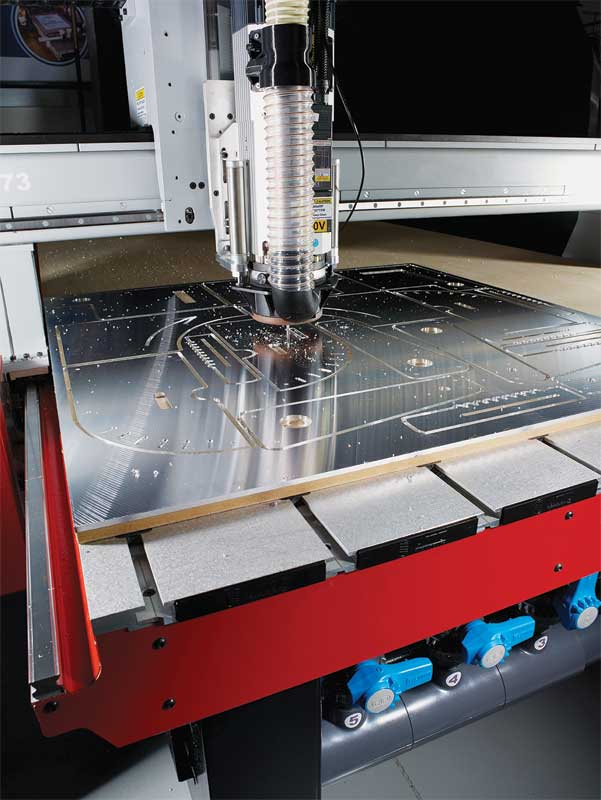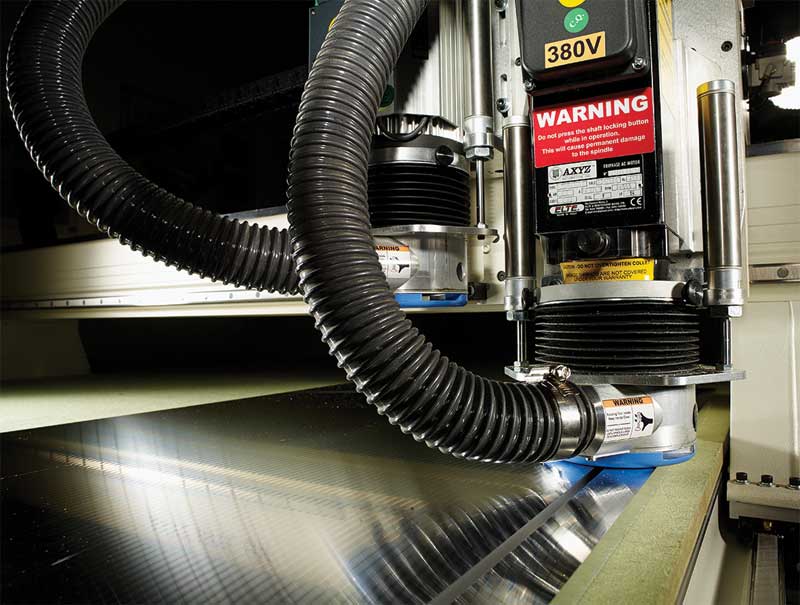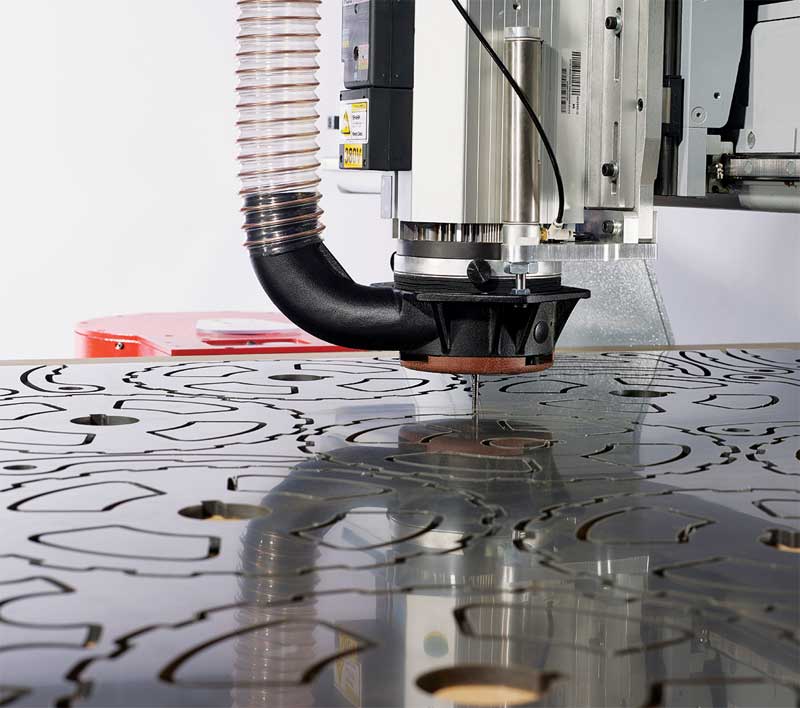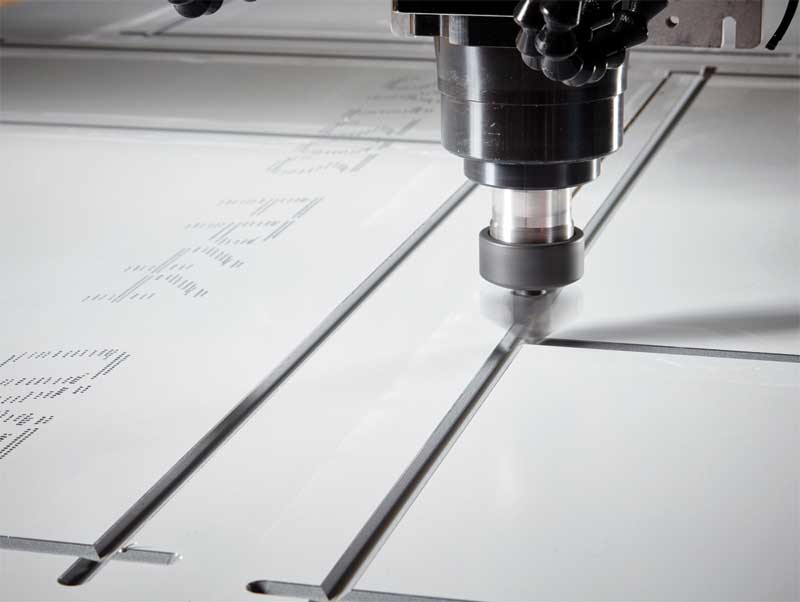CNC Routing: Choosing the right cutting tools
by all | 2 April 2018 3:47 pm
 [1]
[1]Photos courtesy Axyz International
By Robert Marshall
Once a sign shop has invested in a new computer numerical control (CNC) router, whether for the first time or to replace an earlier machine with a next-generation model, the next step is to ensure in-house operators select the right tooling, based on the specific materials to be cut. Using the optimal tooling can help achieve greater productivity and higher quality. There may of course be refinements and corrections to make as time goes on, but it is important to undertake the following basic considerations when initially choosing router bits for sign cutting applications.
Quick and clean cuts
At the most fundamental level, the choice of CNC router tooling determines (a) how quickly a material can be cut and (b) how clean the cut will be.
The cleaner the cut is, the fewer post-routing rework operations will be required. With this in mind, micrograin solid-carbide router bits are the industry norm nowadays. Some of these bits come with a specialized coating, adapting them for use with specific materials. These coatings can both improve the cut and extend the tool’s life.
The geometry matters. The flute design of the bit determines how the cut material will be ejected from the routing table. The most popular geometries are ‘spiral up-cut,’ ‘spiral down-cut,’ straight flutes and compression bits. Selecting the correct diameter of bit helps determine the spindle speed and the cutting depth that may be achieved.
There are other part design considerations, too. Sign designs featuring tight, internal corners will require a smaller router bit diameter than those that are more basic,
like a simple square or rectangle with only external corners.
In general, it is best to select as large a bit diameter as the design will allow, subject to the presence of a spindle with a large enough power rating for the bit. Larger-diameter bits both provide greater rigidity for high-quality cut edges and allow higher cutting speeds to be used.
If polished edges are required, a dedicated bit designed for use with acrylic can eliminate a further step in the process. Sometimes, a more ‘finished’ look can be accomplished with a second pass after the first cut, to remove most of the material. The second pass can be made at a fractionally smaller size (perhaps using a brand-new bit), sloughing off any remaining ‘whiskers’ and smoothing out the edges. There are also durable diamond-tipped tools that can achieve the most polished cuts, but these can be very expensive, so they may not be feasible for many sign shops.
 [2]
[2]After dust is pushed upwards, it is collected by an extraction system.
If the wrong router bit design or size is selected for the specific material to be cut, then the operator may well wind up with chipped, sharp edges or burrs that have to be filed down. The wrong choice of bit can even result in a cut that renders the piece out of tolerance and, thus, headed to the scrap bin.
With tooling, sign shops usually get what they pay for; the less expensive bits may not last as long or cut as well as the more expensive options. As such, tooling with a higher initial cost will pay for itself through greater longevity and improved cut quality. To some extent, the difference is a judgment call.
The selection process is certainly not always black and white. With the wide variety of materials used by sign shops today and demanded by their customers, including many types of plastics, acrylics, wood, aluminum, composites and resins, there may always be some degree of trial and error when it comes to selecting the optimal router bit for a CNC router. There is an ongoing learning process.
Ready access to knowledgeable support from the outside can prove not only helpful, but essential. Sign shops should insist on benefiting from their CNC router vendors’ expertise. Manufacturers and distributors alike should make information about router bit selection available on their websites and on posters that can be mounted to the walls of sign shops.
Generally, when something goes wrong with CNC routing, it is not an issue within the router itself, but with the selected router bit or spindle speed. As such, these problems can be easily fixed, in most cases.
 [3]
[3]Similar extraction systems are available for removing metal chips.
Substrate-specific selections
Cutting aluminum, by way of example, typically calls for an up-cut spiral router bit geometry, which is designed to push the chips and debris from the cut upwards, where they are collected by an extraction system, like a vacuum. This setup helps ensure a cleaner cut, as well.
There are variations among different up-cut tooling options, including the angle of the spiral itself. Some tool manufacturers offer dedicated bits that are designed specifically for aluminum. These should always be the starting point in the selection process, as they generally result in optimum results.
Often, but not always, manufacturers also recommend the use of lubricants when cutting aluminum, in part to extend the life of their router bits. Before lubricants are used, it is important to make sure an automatic misting system is fitted to the machine. This will ensure a consistent and accurate application of lubrication, which is essential for consistent cutting results and extended tool life.
That said, there are tools available that are designed to cut aluminum without using a lubricant. These can offer such benefits as reduced post-routing cleanup time, which
may be an important consideration in a busy sign shop.
For aluminum composite materials (ACMs), which can be grooved and folded, at least two cutters are typically required: one for routing and one for grooving. The latter operation often requires a sharply angled V-cut too, but another option is a ball-nose bit, which is circular on the bottom.
Down-cut spiral router bits, meanwhile, can be used on very thin, flexible aluminum stock, where an up-cut design would tend to lift the material itself off the routing table, causing it to vibrate or move slightly, possibly ruining the cut and throwing it out of tolerance. A down-cut spiral router bit helps push the material down toward the table’s surface, where a vacuum or clamping system can also help keep it in place during cutting operations. The up-cut spiral router bit is typically the tool of choice for aluminum sheets that are thicker than 0.76 mm (0.03 in.).
 [4]
[4]There are many types of plastics for routing, so some trial and error may be needed.
Resin-based medium-density fiberboard (MDF) can be easily cut using an upward spiral router bit, but cutting wood will always involve some variables, of course, depending on the composition of the product. Wood-based sign substrates range from simple plywood to chipboard.
Another factor to consider is whether or not the material to be cut has been laminated or processed with a veneer on the surface. In such cases, it is better to use a straight-fluted or compression bit, which will not lift the cut material up off the surface; whereas an up-cut spiral flute could chip the top surface when cutting a wood-based stock. CNC router manufacturers will often recommend the compression bit, a tool that combines both up-cut and down-cut geometry and tends to push the cut material toward the middle, reducing the chance of chipping the top and bottom edges of wood.
When it comes to routing plastics, such as acrylic, the recommendation is an up-cut router. Indeed, the choices are much the same as with aluminum, but with slight differences in the tooling geometry.
Single up-cut spiral-fluted cutters are the ideal choice for plastics. As with aluminum, however, the down-cut spiral design works better for very thin plastic stock, since the up-cut router would tend to lift lighter material off of the table.
Down-cut spirals are also a better choice when cutting out very small parts, since they will push those routed parts down toward the table bed, instead of trying to lift them like debris due to their minimal surface area.
 [5]
[5]For aluminum composite materials (ACMs), grooving often requires a sharply angled V-cut.
Continual improvement
Any chipping, rough edges and/or burring will alert experienced CNC router operators, indicating they are using the wrong tool—or one that has been worn down. They will also be able to tell how well a specific bit is performing by the sound it makes.
Beyond these indicators, whenever there is any doubt about the correct angle, flute, bit size, spindle feed or speed, signmakers should seek out the expertise of CNC router manufacturers, taking advantage of the ‘lifeline’ offered either online or through direct contact.
It is worthwhile keeping in mind that cutting technology changes. New tooling options continue to enter the CNC routing market on a regular basis. Keeping up-to-date on what is available can help a sign shop continue to increase productivity and reduce waste.
Signmakers should not be afraid to tweak their CNC tooling selections over time. There is always an end goal of achieving as perfect results as possible.
Robert Marshall is vice-president (VP) of market development for Axyz International, which manufactures CNC routers and knife systems in Burlington, Ont., and maintains application development centres around the world. For more information, visit www.axyz.com.[6]
- [Image]: https://www.signmedia.ca/wp-content/uploads/2018/04/Processing-Aluminum-sheet.jpg
- [Image]: https://www.signmedia.ca/wp-content/uploads/2018/04/profile-cutting-ACM-with-dust-extraction-foot.jpg
- [Image]: https://www.signmedia.ca/wp-content/uploads/2018/04/Cutting-Aluminum-with-chip-extraction-foot.jpg
- [Image]: https://www.signmedia.ca/wp-content/uploads/2018/04/plastic-components.jpg
- [Image]: https://www.signmedia.ca/wp-content/uploads/2018/04/V-Grooving-ACM.jpg
- www.axyz.com.: http://www.axyz.com
Source URL: https://www.signmedia.ca/cnc-routing-choosing-the-right-cutting-tools/